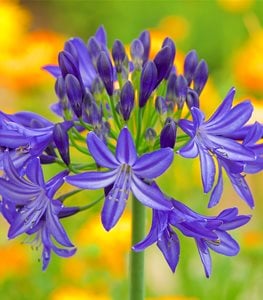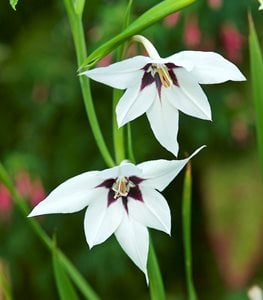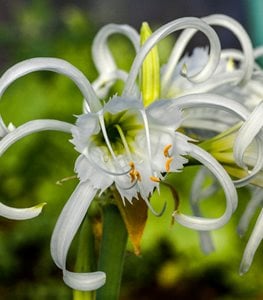20 BEST SUMMER BULBS TO GROW
Add beauty to your summer garden with these bulbs to plant in springGardeners usually think about bulbs for spring color in the landscape, but there are many bulbs that provide summer interest as well. Most summer flower bulbs and foliage bulbs are tropical in origin and need warmer conditions to thrive.
Summer-blooming bulbs can be planted in beds, borders, containers, or hanging baskets. They come in different forms, including true bulbs, corms, rhizomes, and tubers. Here are some of the best bulbs to plant in spring for summer flowers:
On this page: Summer Bulbs | Buying, Planting, and Growing Summer Bulbs
On this page:
SUMMER BULBS
ASIATIC LILY (Lilium hybrids)
Zones: 3-8
Exposure: Full sun to partial shade
Bloom time: Early to mid-summer
Height/Spread: 1 to 5 feet tall, 1 to 2 feet wide
Uses: Grow in a mixed border in combination with peonies, roses, and daylilies, plant by themselves in a container or in combination with other plants.
This hardy easy-care lily is one of the earliest to bloom. Unscented flowers come in a wide range of colors and patterns. Lilies are highly toxic to cats.
Learn more about growing lilies.
BEGONIA (Tuberosa group)
Zones: 9-11
Exposure: Partial to full shade
Bloom time: Mid-summer to fall
Height/Spread: Bushy or trailing habit; 6 to 18 inches tall, 12 to 18 inches wide
Uses: Suitable for containers, hanging baskets or window boxes. Can also be used as a bedding plant.
Light up a deeply shaded area with large rose-like blooms that occur in bright hues of yellow, orange, red, pink, and white. Flowers bloom nonstop and need no deadheading. Allow this tropical heat lover to dry out slightly between waterings and provide good drainage to prevent tuber rot. Treat as an annual or store the fleshy tubers indoors over winter.
Learn more about growing begonias.
CALADIUM (Caladium bicolor)
Zones: 9-11
Exposure: Partial to full shade
Bloom time: Flowers are insignificant or non-existent
Height/Spread: Upright spreading habit; 12 to 24 inches tall, 8 to 24 inches wide
Uses: Caladiums do well in containers and window boxes and can be treated as a houseplant, though plants go dormant in winter.
This heat-loving tropical is grown for its heart-shaped foliage in an array of colors and patterns. Caladiums are grown as an annual in all but the warmest regions. Plant in a shady area by itself or in combination with other shade lovers such as ferns, impatiens, or wishbone flower. Leaves will burn if placed in full sun. Bulbs can be overwintered indoors for planting the following spring.
Learn more about growing caladiums.
CALLA LILY (Zantedeschia spp.)
Zones: 8-10
Exposure: Full sun to partial shade
Bloom time: Early to late summer, depending on the variety
Height/Spread: Upright habit; 2 to 3 feet tall, 1 to 2 feet wide
Uses: Grow in a container on a patio or deck, or place at the front of a border to enjoy the blooms up close.
Calla lilies are grown for the elegant showy inflorescence and broad green or speckled foliage. A favorite of florists, calla lilies come in an array of colors and are produced from rhizomes or tubers. Bulbs can be overwintered indoors to replant the following spring.
Learn more about growing calla lilies.
CANNA LILY (Canna spp.)
Zones: 7-11
Exposure: Full sun
Bloom time: Mid-summer to fall
Height/Spread: Upright spreading habit; 1-1/2 to 8 feet tall, 1-1/2 to 6 feet wide
Uses: Grow in a mixed border or container, or mass in a bed.
Not a true lily, cannas are produced from rhizomes and are related to bananas and flowering ginger. The bold foliage with striking patterns and colors lends a tropical feel to the landscape. Flowers occur in hues of red, pink, coral, white, yellow, and orange. Rhizomes can be left in the ground in warmer regions. In colder areas, bring pots inside or lift rhizomes to store indoors.
CROCOSMIA (Crocosmia cultivars and hybrids)
Zones: 5-9
Exposure: Blooms best in full sun, but can take some partial shade
Bloom time: Mid to late summer
Height/Spread: Upright spreading habit; 1-1/2 to 4 feet tall, 1 to 2 feet wide
Uses: Grow in a mixed border; smaller forms can be grown in containers. Flowers are especially attractive to hummingbirds.
Also known as montbretia, this iris relative produces strappy foliage and stately flower spikes in sunset hues of red, orange, yellow, and coral. The small rounded corms can be left in the ground in warmer climates or dug and stored over winter. Plants need good drainage.
Learn more about growing crocosmia flowers.
DAHLIA (Dahlia cultivars)
Zones: 7-10
Exposure: Full sun
Bloom time: Mid-summer to frost
Height/Spread: Upright bushy habit; 1 to 6 feet tall, 1 to 3 feet wide
Uses: Use in garden beds or large containers. Excellent for flower arrangements.
One of the most beloved summer flowers, this Mexican native comes in an endless array of flower colors, forms, and sizes—from 2-inch pompons to giant 10-inch dinnerplates. Plant size ranges from dwarf border types to taller forms. Tubers can be left in the ground in warmer climates or lifted and stored over winter. Plants need good drainage and moderate water.
Learn more about growing dahlias.
ELEPHANT EAR (Colocasia esculenta)
Zones: 8-11
Exposure: Full sun to partial shade
Bloom time: Flowers are rare or non-existent
Height/Spread: Upright vase shaped; 3 to 8 feet tall and wide
Uses: This water lover can be placed alongside a pond or stream, in a garden bed or container.
This tropical perennial is grown for the giant heart-shaped leaves that can reach 2 feet across. Also known as taro, the foliage occurs in colors of green, purple, or nearly black, some with speckled or lined patterns. The large bulbs can be left in the ground in warmer climates or dug and stored indoors over winter.
Learn more about growing elephant ear plants.
GLADIOLUS (Gladiolus spp. and cultivars)
Zones: 8-10
Exposure: Full sun
Bloom time: Early summer to frost
Height/Spread: Upright narrow habit; 2 to 5 feet tall, up to 1 foot wide
Uses: A longtime staple of cutting gardens. Plant in a border or long rows. Hummingbirds and butterflies love them.
This classic summer bulb has tall flower spikes that produce a succession of trumpet-shaped flowers in nearly every color imaginable. Plant in rich, well-draining soil; taller varieties may need staking. In Zone 7 or colder, dig the corms in fall and replant the following spring.
Learn more about growing gladiolus.
GLORIOSA LILY (Gloriosa superba)
Zones: 8-10
Exposure: Full sun to partial shade
Bloom time: Mid to late summer
Height/Spread: Vining habit; 5 to 8 feet tall, 1 to 3 feet wide
Uses: Grow in the ground or containers and combine with other vining plants on a trellis or arbor.
Elegant red, yellow, or orange lily-like flowers of this climbing vine are grown from potato-like tubers that can multiply vigorously in warmer climates. Tubers can be overwintered indoors or mulched in the ground in Zone 8 or higher.
IRIS (Iris spp.)
Zones: 3-10
Exposure: Full sun to partial shade. Plant in full sun for best bloom.
Bloom time: Mid-spring to fall
Height/Spread: Upright spreading habit; 6 to 48 inches tall, 12 to 36 inches wide
Uses: Plant in beds or borders.
A diverse group of long-lived perennials; there are hundreds of species that bloom from mid-spring to fall, depending on the type. Flowers occur in a wide range of color combinations and patterns. Bearded iris (I. germanica), which are the most common, bloom from late spring to early summer, with some varieties reblooming in late summer or fall.
Learn more about growing iris flowers.
LILY OF THE NILE, AFRICAN LILY (Agapanthus spp.)
Zones: 7-11 for most varieties; others can survive Zones 5-6 with heavy mulching in winter
Exposure: Full sun to partial shade
Bloom time: Mid-summer to early fall
Height/Spread: Upright spreading habit; 1-1/2 to 4 feet tall, 1 to 2 feet wide
Uses: Grow this carefree plant in beds or containers.
Globe-shaped clusters of florets in hues of blue, purple, or white occur on long, graceful stems. The broad strappy foliage is green or variegated. Also known as African lily, this exotic looking South African native grows and spreads through fleshy rhizomes that are easily divided to create new plants.
Learn more about growing lily of the nile plants.
MEXICAN SHELL FLOWER (Tigridia pavonia)
Zones: 8-10
Exposure: Full sun
Bloom time: Mid to late summer
Height/Spread: Upright slender habit; 1 to 2 feet tall, 5 inches wide
Uses: Plant in a bed or container.
Unusual three-petaled flowers with speckled centers come in shades of red, orange, yellow, pink, white, and coral. Also called tiger flower, the flower patterns resemble tiger markings, hence the name. Each stalk produces several consecutive blooms, with individual flowers lasting one day. Corms can be dug and overwintered indoors in colder climates.
ORIENTAL LILY (Lilium hybrids)
Zones: 6-9 for most varieties; others can survive to Zone 4 with heavy mulching in winter
Exposure: Full sun to partial shade
Bloom time: Summer
Height/Spread: Upright habit; 2 to 6 feet tall, 6 to 24 inches wide
Uses: A favorite cut flower in the floral trade and grow well in containers.
This summer bloomer is known for its large open-faced flowers that are exceptionally fragrant. Flowers come in eye-catching patterns, with colors including pink, orange, yellow, red, and white. Plant near a patio or deck where the deep perfume can be enjoyed up close. Lilies are highly toxic to cats.
PEACOCK ORCHID (Gladiolus murielae, formerly Acidanthera bicolor)
Zones: 7-10
Exposure: Full sun
Bloom time: Late summer
Height/Spread: Upright habit; 2 to 3 feet tall, 1 to 1-1/2 feet wide
Uses: Plant in a bed or container in clusters of 6 or more bulbs for the greatest impact.
Peacock orchid has upright sword-like foliage and fragrant orchid-like flowers that are white with a dark burgundy center. In colder regions, corms can be dug and overwintered indoors.
PERUVIAN DAFFODIL (Hymenocallis spp. and cultivars)
Zones: 8-10
Exposure: Full sun
Bloom time: Mid-summer
Height/Spread: Upright habit; 18 to 24 inches tall, 8 to 10 inches wide
Uses: Naturalize in a border or mass in a container for the greatest impact. The long stems make for good cut flowers.
Also known as spider lily, the trumpet shaped flower center is surrounded by 6 spidery petals. Scented blooms are white, cream, or yellow. Plants are deer-resistant. Bulbs can be lifted and stored indoors over winter in colder regions.
PINEAPPLE LILY (Eucomis spp.)
Zones: 7-10
Exposure: Full sun to partial shade
Bloom time: Mid-summer to early fall
Height/Spread: Upright habit; 1 to 3 feet tall and 5 inches wide. Bulbs will multiply over time, with clumps reaching 2 to 3 feet wide
Uses: Grow in a mixed border in combination with other plants, or by itself in a container.
Spikes of tiny star-shaped flowers are topped with leaflike bracts resembling those of a pineapple, hence the common name. Tall flower stalks, which can be green, purple, or speckled, rise above the broad strappy foliage. Blooms occur in colors of green, purple, pink, yellow, or white. Provide good drainage. Bulbs can be lifted and stored indoors over winter in colder climates.
Learn more about growing pineapple lilies.
RAIN LILY (Zehyranthes spp.)
Zones: 7-10
Exposure: Full sun
Bloom time: Mid-summer to fall
Height/Spread: Upright spreading habit; 1 to 2 feet tall and wide
Uses: Use these diminutive plants in a rock garden, container or at the front of a border.
Also known as zephyr lily, this amaryllis relative is native to the Southeastern US, Central America, and South America. In the wild, plants will often bloom following a heavy rainfall, hence the name. Flowers occur in hues of pink, peach, orange, white, or yellow. Bulbs can be dug in fall and overwintered indoors in colder regions.
RESURRECTION LILY (Lycoris squamigera)
Zones: 5-9
Exposure: Full sun to partial shade
Bloom time: Late summer to fall
Height/Spread: Upright spreading habit; 1 to 2 feet tall and wide
Uses: Because the bare stems can look stark in the landscape, naturalize in a border or meadow among other plants where the stems will be less apparent. Can also be grown in containers.
Also known as magic lily or surprise lily, this amaryllis relative is named for the clusters of showy blooms that are produced on leafless stems after the foliage dies back. Fragrant trumpet-shaped flowers are rose pink. Foliage appears in late winter, dying back by late spring before the flowers appear in summer.
SHAMROCK PLANT (Oxalis spp.)
Zones: 7-10; some varieties more cold tolerant
Exposure: Full sun to partial shade
Bloom time: Early to late summer
Height/Spread: Mounding spreading habit; 3 to 16 inches tall, 3 to 12 inches wide
Uses: Use as border or pathway edging, or in containers.
A member of the wood sorrel family, shamrock plant is grown for the attractive triangular or heart-shaped foliage. Flowers are white, pink, yellow, or bicolored, while the showy foliage occurs in colors of green, burgundy, purple, silver, and bicolors. Grown from tender rhizomes or bulbs, some can be vigorous spreaders when grown in optimal conditions. Overwinter rhizomes indoors in colder regions.
Learn more about growing shamrock plants.
BUYING, PLANTING, AND GROWING SUMMER BULBS
When to buy summer blooming bulbs:
Summer blooming bulbs are available for sale at garden centers and online sources beginning in late winter or early spring. True lilies are sometimes also sold for fall planting. Some, such as caladium, calla lily, and tuberous begonia may also be offered as nursery-grown plants in spring.
How to choose good bulbs:
Bulbs should be firm and blemish-free.
When to plant summer bulbs:
Summer-blooming bulbs are planted in spring. Wait until conditions are warm enough to plant bulbs outdoors, as bulbs can rot if soil is too cool. Soil temperature should be at least 60 degrees or higher.
To get a jump start on the growing season, bulbs can be potted up a month or two before moving them outdoors. Leave in containers or transplant when temperatures are warm enough to plant.
Where to plant summer bulbs:
Choose the right site conditions for each variety, taking into consideration light, temperature, and soil.
How to plant summer bulbs:
- Amend soil with compost or other organic matter and provide adequate drainage to prevent rot.
- Plant bulbs at the proper depth. In general, two to three times the depth of the bulb size.
- Stake plants such as dahlias at the time of planting to provide support.
- Feed bulbs at the time of planting, then broadcast fertilizer during the growing season. Use an all-purpose organic fertilizer according to package instructions for best bloom.
Watering summer bulbs:
Provide regular water, allowing soil to dry out between watering. Some plants, such as Crocosmia, are adaptable to drier conditions, while others such as elephant ears thrive with lots of moisture.
Overwintering tender summer bulbs:
- For bulbs that need to be dug up: Many summer bulbs can be saved for the following growing season by overwintering indoors. Wait until the first hard frost kills the leaves before digging. Remove excess soil and cut back dead foliage. Place bulbs in peat moss or wood shavings in an open paper bag or ventilated container. Store in a cool, dry place such as a basement or heated garage in temperatures 40 degrees to 60 degrees F. Discard bulbs that become mushy or smell bad due to rotting.
- For bulbs that remain in the ground: Mulch over the bulbs with several inches of leaves, straw, or pine needles to insulate from colder temperatures.
- For bulbs in containers: Bulbs planted in containers can be left in the pot and moved indoors until the following spring.
RELATED:
Bulbs 101: How & When to Plant Bulbs
7 Tips for Beautiful Bulb Garden Design
Popular Flower Bulbs
Top 20 Spring-Blooming Bulbs




















